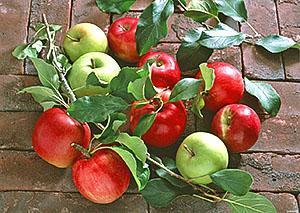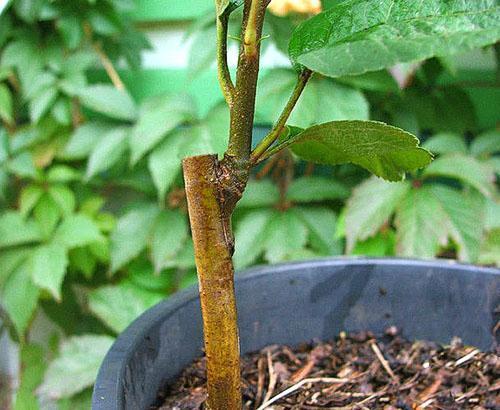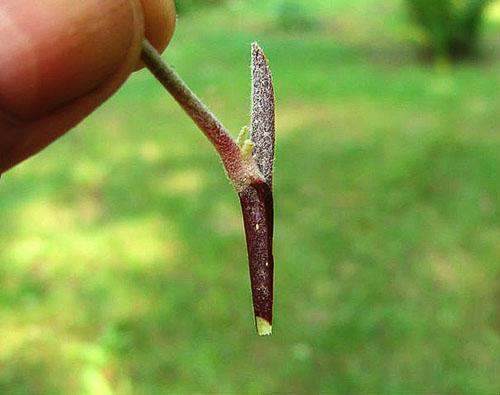We do the budding of apple trees in the summer
 Gardeners consider grafting with a bud or eye to be the easiest and most affordable way to get a new variety on the site or to improve an already growing tree. The name of the vaccination method, budding, comes from the Latin word oculus, which means “eye”.
Gardeners consider grafting with a bud or eye to be the easiest and most affordable way to get a new variety on the site or to improve an already growing tree. The name of the vaccination method, budding, comes from the Latin word oculus, which means “eye”.
Due to the relative simplicity, the ability to graft a plant in the summer, high survival rate with the help of budding, most seedlings of apple trees, pears and other fruit and ornamental plants emerging from nurseries are obtained.
When and how to properly graft an apple tree by budding?

- For spring budding, a growing bud is used, formed in the last season and giving the first growth in the coming one.
- The budding of apple trees in summer is carried out by a dormant bud formed over the past months of the season. In this case, a new shoot should be expected only next year, when the vaccine starts to grow.
At the time of the procedure, it is important that the bark on the rootstock for the apple tree can be easily separated from the wood, and the grafting itself can be performed in two ways:
- Budding an apple tree with wood is the simplest and fastest way of grafting, in which you will have to separate the bark only from the rootstock area.
- For budding without wood, you have to wait for the moment when the bark easily leaves both the rootstock and the scion.
Practice shows that the best survival rate of eyes on fruit trees is observed if budding was carried out 2-3 weeks before the moment when the average daily temperature drops to 15 ° C.
Grafting will be less painful for the tree in cool, dry weather. If it's sunny outside, budding apple trees in summer is carried out from dawn to 10 am or after 4 pm to sunset. If the sky is covered by clouds and the plant is not in danger of burning, in the daytime, vaccinations are done without restrictions. At the same time, first of all, those trees in which the growing season ends earlier are grafted.
To activate the movement of juices and create better conditions for future wintering two weeks before budding, in any weather, apple rootstocks are good watered... And also in advance, and better still in early spring, 25 cm above the place of the proposed budding of the stock, whether it be wild or skeletal branches of an apple tree of another variety, are cut off.
Budding is usually done on the north side of the rootstock, choosing a convenient site 5–6 cm above the root collar. If, due to the rainy climate, there is a risk of scion undermining, the apple tree is grafted:
- at a height of 10 cm from the soil level on light soils;
- on dense clay soil, budding is carried out even higher - at a height of up to 15 cm.
On the root collar, apple budding is done closer to autumn, when it is no longer possible to separate the bark in other areas. A height of 10 cm from the ground surface is considered optimal.
Budding apple tree with wood
 When budding in this way, a thin piece of wood is cut off from the scion, thickening in the bud area. In this case, the vascular-fibrous bundle going to the eye is cut, and the flap itself has a length of 15 to 25 mm and the same width throughout the entire length.Such grafting material should be held by the leaf petiole, but if it is absent, it is worth cutting the flap 1 cm longer in order to hold on to the upper tip and cut it off after the flap is inserted on the stock.
When budding in this way, a thin piece of wood is cut off from the scion, thickening in the bud area. In this case, the vascular-fibrous bundle going to the eye is cut, and the flap itself has a length of 15 to 25 mm and the same width throughout the entire length.Such grafting material should be held by the leaf petiole, but if it is absent, it is worth cutting the flap 1 cm longer in order to hold on to the upper tip and cut it off after the flap is inserted on the stock.
On the rootstock do:
- from the bottom up, a transverse incision at the site of the future vaccination;
- semicircular longitudinal incision.
 As a result, the peephole inserted into the T-shaped incision should be tightly pressed against the wood of the apple tree stock, and the bud is located closer to the bottom of the slot in the bark, which contributes to better fusion. When the shield is inserted, it is squeezed from the bottom upwards and the graft site is tied, closing or leaving the bud of the scion in the air, however, if the entire surface of the shield with the bud is under the tape and does not dry out, fusion is more effective.
As a result, the peephole inserted into the T-shaped incision should be tightly pressed against the wood of the apple tree stock, and the bud is located closer to the bottom of the slot in the bark, which contributes to better fusion. When the shield is inserted, it is squeezed from the bottom upwards and the graft site is tied, closing or leaving the bud of the scion in the air, however, if the entire surface of the shield with the bud is under the tape and does not dry out, fusion is more effective.
Budding apple trees in summer without wood
 Such a summer budding of an apple tree, although a little more complicated than the method described above, but the absence of wood increases the chances of fusion of the rootstock and scion tissues. In this case, the cut begins one centimeter above the kidney and ends at least 0.7 cm below it. To separate the section of the cortex with the kidney and the vascular-fibrous bundle, the eye is pressed from the side, as if moving from the handle.
Such a summer budding of an apple tree, although a little more complicated than the method described above, but the absence of wood increases the chances of fusion of the rootstock and scion tissues. In this case, the cut begins one centimeter above the kidney and ends at least 0.7 cm below it. To separate the section of the cortex with the kidney and the vascular-fibrous bundle, the eye is pressed from the side, as if moving from the handle.
If, during removal, it turns out that the bundle on the back of the cortex could not be preserved, the kidney is not suitable for budding, and the procedure will have to be repeated.
The technique of cutting the rootstock and the subsequent insertion of the eye does not differ from the method described above. True, in the case of budding without wood, it is somewhat more difficult to fix the kidney due to the folding of the drying bark. Therefore, skill is especially important here. In order to easily vaccinate an apple tree with a kidney in the summer, the video clearly explains all the subtleties of the process, methods of working with a grafting knife and how to strap the place where the eye is inserted.
Budding an apple tree with two buds
Many gardeners know that grafting different fruit trees does not always give the desired result. How to properly plant an apple tree with poor survival rate and insure against frost damage or other causes of scion death? It is in such situations that it is useful to use budding with two buds, where the gardener deliberately creates a reserve and the ability to choose the best of the resulting shoots in the spring.
If two buds are oculated at the same time, the eyes are grafted onto the stock one above the other on opposite sides of the stem or branch.
Summer grafting of an apple tree with a kidney "applied"
 Such budding of an apple tree in summer can be useful if:
Such budding of an apple tree in summer can be useful if:
- time is lost, and the bark at the rootstock for the apple tree does not leave;
- the stock is too thick or, conversely, thin for the methods of grafting already discussed.
 Making a cut on the rootstock, in this case, the grafting knife is placed at an angle and, by analogy with budding, a semicircular incision is made, but together with the bark, cutting through a small layer of wood. The bark is cut from the rootstock area, making a second incision 25–30 mm higher from the first cut. The shield from the scion is cut off approximately the same size as the prepared area on the rootstock, after which it is inserted directly from the knife into the place allotted to it and the grafting site is wrapped.
Making a cut on the rootstock, in this case, the grafting knife is placed at an angle and, by analogy with budding, a semicircular incision is made, but together with the bark, cutting through a small layer of wood. The bark is cut from the rootstock area, making a second incision 25–30 mm higher from the first cut. The shield from the scion is cut off approximately the same size as the prepared area on the rootstock, after which it is inserted directly from the knife into the place allotted to it and the grafting site is wrapped.
Checking the survival rate of the kidneys after budding
Two weeks later, after budding the apple tree in the summer, you can determine how much the buds have taken root. To inspect the vaccination, the harness is loosened, trying not to disturb the peephole, and then the wrapping is made again, which should remain until September.
The well-being of the eye is indicated by the dried leaf petiole and the shiny surface of the bud that has slightly increased in size. If the procedure was unsuccessful, but the weather allows repeating budding, the grafting is repeated in any suitable way, but already above or below the dried cut or on the other side of the shoot.
Is it possible to plant an apple tree on a pear
 The key to good tissue fusion of the scion and rootstock for an apple tree is not only competent budding and correctly chosen timing, but also how well the plants are compatible. The related species are as close as possible, but is it possible to plant an apple tree on a pear? Since both plants belong to the Rosaceae family, the gardener has a chance to see pears ripening on Antonovka or Bellefleur. But as practice shows, many of these experiments still ended in failure. But the budding of a pear eye on an apple tree, a quince, as well as on a hawthorn and mountain ash passes without serious problems.
The key to good tissue fusion of the scion and rootstock for an apple tree is not only competent budding and correctly chosen timing, but also how well the plants are compatible. The related species are as close as possible, but is it possible to plant an apple tree on a pear? Since both plants belong to the Rosaceae family, the gardener has a chance to see pears ripening on Antonovka or Bellefleur. But as practice shows, many of these experiments still ended in failure. But the budding of a pear eye on an apple tree, a quince, as well as on a hawthorn and mountain ash passes without serious problems.